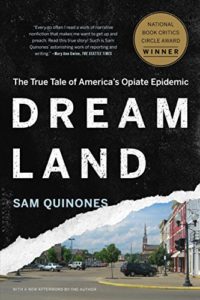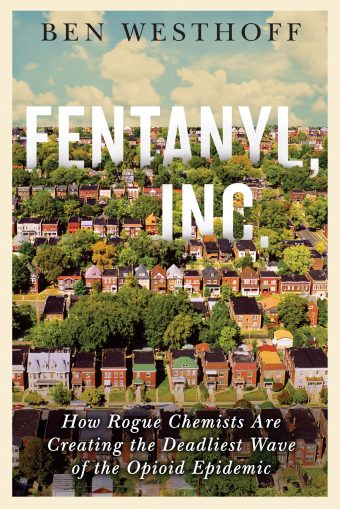
Understanding the American Drug Crisis: A Reading List
Ben Westhoff on How Nonfiction Helps Us Move Beyond the Headlines
Despite the daily deluge of opioid crisis reports, you might not know that drug deaths rates aren’t just bad—they’re worse than they’ve ever been. Though last year’s tally is projected to tick down slightly from the year previous, around 70,000 Americans per year are dying from drug overdoses, which is more than from guns and more than the peak of the AIDS crisis, even driving down US life expectancy.
Great nonfiction books on the subject help us move beyond the headlines and understand how addiction and overdose impact families and communities. Drug trafficking also affects global politics, with President Trump regularly threatening Earth’s other superpower, China, for not controlling its illicit export of fentanyl, which is spurring the American crisis.
I spent four years reporting my new book Fentanyl, Inc.: How Rogue Chemists Are Creating the Deadliest Wave of the Opioid Crisis, spending time with addicted users and health care professionals. I spoke with both law enforcement officers and harm reduction activists who would dismantle nearly every aspect of current drug control policy. Focusing on new drugs like fentanyl, K2, and cheap, dangerous replacements for LSD and ecstasy, I embedded with corner dealers and Dark Web distributors, and even infiltrated a pair of fentanyl operations in China. I found that, despite China’s promises to curb this illicit industry, it is actually encouraging it through the tax code.
My work built on the nonfiction drugs books below. Many of their authors have also traveled the world, risking their personal safety to understand drug frontiers impacting users at home. Others were involved in seminal moments in drug history, from the so-called “Godfather of Ecstasy” to a young woman who accidentally stumbled onto the country’s biggest LSD lab. Each of these works are as readable as they are informative, and help us understand how we got from “Just Say No” to a swelling international crisis.

Sam Quinones, Dreamland: The True Tale of America’s Opiate Epidemic
Most of America’s heroin comes from Mexico, but until the 1990s the cartels mainly trafficked it to the major cities. This left major swaths of the US map up for grabs, and so small groups of traffickers fanned out around the United States to previously under-served markets like Nashville, Tennessee, and Boise, Idaho. Most of them came from the small Mexican county of Xalisco; they were a steady pipeline of young men coming to America with hopes of getting rich. Unlike traditional dealers, however, they weren’t armed, and the focus was on customer service. They handed out business cards at methadone clinics, and made home deliveries.
Quinones shows how the overprescription of opioid pills by American doctors opened up this market, and how law-abiding citizens turned to the Xalisco heroin dealers when their prescriptions ran out. Dreamland is a monumental work of reporting and analysis. At its heart, the book is about the effects of a single molecule so powerful it can produce both the greatest pleasure possible, and the greatest suffering.

Johann Hari, Chasing the Scream: The First and Last Days of the War on Drugs
No matter where you come from or how old you are, you’ve likely been given misinformation about drugs for most of your life. Chasing the Scream is one of those “everything you know is wrong” texts that uses first-hand reporting from around the globe to show how we’ve gotten in wrong, and how we can right the ship. Hari travels from Arizona—where prison camps try to humiliate users into going straight—to Portugal, where decriminalization has actually helped solve drug problems. Most astonishing is his reporting on heroin abuse. Counter to the traditional narrative that once an opiate or opioid get its “chemical hooks” into users it’s nearly impossible for them to break free, Hari shows the situation to often be less chemical than psychological. If users can get their personal lives in order, they can frequently get clean.

Alexander Shulgin & Ann Shulgin, PiHKAL: A Chemical Love Story and TiHKAL: The Continuation
Chemist Alexander “Sasha” Shulgin began his career at Dow Chemical. After he created an extremely-profitable insecticide they let him work on whatever he wanted, which happened to be psychedelic drugs. His mind-expanding creations turned out to be too much for Dow, but, brewing up potions in his mad-scientist lab across the Bay from San Francisco, Shulgin made countless new drugs from scratch, sampling them himself to understand their effects. He thought these chemicals could benefit everything from science to religion, and, in particular, believed MDMA could aid psychiatry, thus earning him the nickname “Godfather of Ecstasy.” He published detailed synthesis techniques for his drugs in his 1991 tome, PiHKAL (Phenethylamines I Have Known and Loved) and in 1997 followed it up with TiHKAL (Tryptamines I Have Known and Loved).
The books are co-authored by his wife Ann, who goes beyond the chemistry to describe their courtship, research, and many psychedelic trips—4,000 for him, and about half of that for her. The books have been staggeringly influential, inspiring a generation of do-it-yourselves chemists to tweak the chemical structures of known drugs to try to make new ones. The DEA was not amused, however, and in 1994 raided the Shulgin property, stripping its patriarch of the DEA-granted drug-making license he somehow possessed.

Mike Power, Drugs Unlimited: The Web Revolution That’s Changing How the World Gets High
Drugs Unlimited is the first book about novel psychoactive substances, formerly known as designer drugs. These are the new psychedelics, amphetamines, opioids, cannabinoids and other drugs replacing traditional recreational substances, and they are the direct result of Sasha Shulgin’s do-it-yourself revolution. When Shulgin first published PiHKAL chemists thumbed through the thick tome in their labs, but the Internet age brought drug recipes to psychonauts around the world, who could share their musings on chat boards and even buy and sell online. This spawned an entire industry of new drugs that were largely made in China, which upended drug policy around the world.
Of course, as Power shows, most governments reacted reflexively, criminalizing them all without considering the consequences, and often inspiring more insidious substances in their wake. The book is revelatory throughout, but perhaps most compelling is the story of how international crackdowns on Cambodian traffickers harvesting ecstasy ingredients from native trees created a massive MDMA drought in English rave culture. This led to an influx of new chemicals used to make fake ecstasy pills, many of which led to deaths.

Ko-lin Chin and Sheldon X. Zhang, The Chinese Heroin Trade: Cross-Border Drug Trafficking in Southeast Asia & Beyond
Though countries like Afghanistan, Mexico, and Colombia, and the “Golden Triangle” region in Southeast Asia have long produced the world’s illicit drugs, China is quickly taking center stage. My book Fentanyl, Inc. focuses on China’s role as a producer of fentanyl and novel psychoactive substances—almost all of which are exported to the West—while The Chinese Heroin Trade, published in 2015, concerns traditional drugs like heroin and meth, which China both makes and consumes in great quantities. Very little has been published about the subject, making this book particularly valuable. It traces how Chinese history, culture, and criminal institutions shaped its drug industry. Unlike violent Latin American cartels, these Chinese organizations eschew violence, preferring to make money quietly.
Perhaps most shocking is the book’s exploration into how China treats its own drug abusers—basically like criminals. Citizens can be executed for possessing small amounts of drugs, and those who escape this fate are often sentenced to years of hard labor. It’s a fascinating peek inside a secretive regime, one whose policies are shaping drug trends around the world.

Krystle Cole, Lysergic
Cole was working as a stripper outside of Topeka, Kansas in 2000 when a tall, strange man carrying a metal briefcase named Gordon “Todd” Skinner came into her club. They hit it off, and he ushered her into his playground of psychedelic substances, located in a decommissioned underground Atlas E missile silo. He soon imparted that he helped run one of the largest LSD laboratories in the world. It was all fun and games until Skinner became paranoid, turning himself in after being granted immunity for testifying against his partner, William Leonard Pickard.
I won’t spoil the ending, but Lysergic is part bizarre love triangle, part psychedelic treatise, part true crime story. Cole’s no-frills writing moves quickly, and the story is captivating; though some aspects of her account have been disputed, it is an indispensable window into a case that had implications for the international drug trade.
_________________________________________

Ben Westhoff’s Fentanyl, Inc is out now from Grove Atlantic.
Ben Westhoff
Ben Westhoff writes about culture, drugs, and poverty. His books are taught nationwide and have been translated around the world. He is the author of Original Gangstas, the definitive history of West Coast hip-hop, and Fentanyl, Inc., the bombshell first book about fentanyl, and now speaks at opioid conferences across the country. He is the Executive Editor of Euclid Media Group and lives in St. Louis, Missouri, with his wife and two children.



















